We play a genuine '54 Fender Stratocaster
Up close and personal with a legend
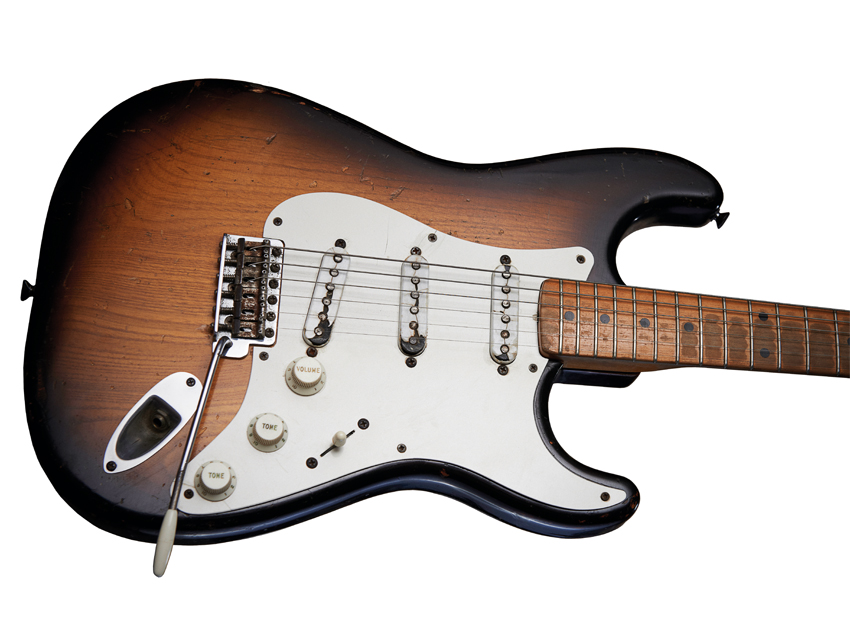
We play a genuine '54 Fender Stratocaster
60 DAYS OF STRAT: The guitar has always been totemic, to a degree. Many are the tales of wide-eyed hopefuls stood agog at music-shop windows, transfixed by a stringed conduit of wonder and possibility.
These days, that shop window is more likely to be on your computer screen than in your high street, but it’s still happening every day, all over the world. This guitar, with its drop-dead curves and near-perfect functionality, has transcended totemic status.
In its 60 years to date, the Fender Stratocaster has nestled right in there alongside the Ray-Ban Wayfarer and Levi’s 501s as a staple of 20th century culture and design that remains 100 per cent relevant. Much imitated, never equalled, not old, not new: it just is. You might even call it timeless.
Like you, I remember the first time I ever saw one, for real, up close. I was 14 and our local pub had a band on. My dad insisted I watched them, having noticed the spark of enthusiasm in me ignited by electric blues. “You might learn something,” he said. “And he plays a real Strat!” Nobody I knew had a real Strat.
The Aran B Sweaters featured one Marco Rossi on the fabled Fender, punching out Albert Collins and T-Bone Walker licks among many others, through a 4x10 Fender Concert. The combination made noises that stirred something very deep that remains with me to this day. My dad was right, I did learn something, and I’m still learning.
I was thinking about Marco on the plane to Umeå, Sweden, back in January this year. It’s probably down to him I was making this journey at all; it’s probably down to him that what’s at the end of it will excite me more than any rock band or superstar ever could. I know it’s not a minter, I know it’s not 100 per cent original, but in many ways, that’s what makes it all the more interesting...
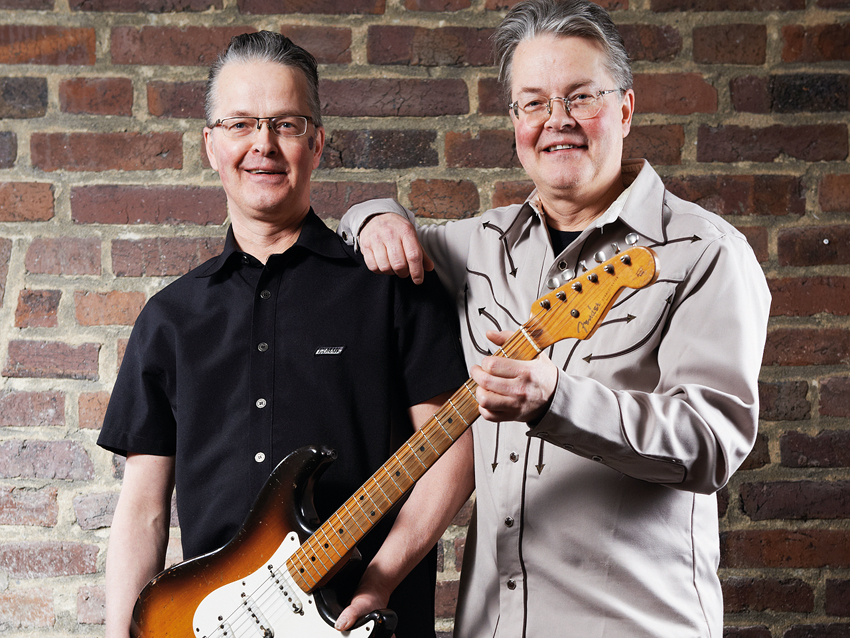
The brothers
Twin brothers Mikael and Samuel Åhdén have quite a few guitars. Over 300, it’s said, and thanks to the considerable efforts of a small team of collaborators and the municipality of their home town, Umeå, they’ve offered their collection up for public display in Guitars: The Museum.
Throughout a handful of breathtakingly grand rooms, walls are augmented with gigantic glass cases, each containing treasures that may as well be the Crown Jewels to people like us, albeit way more interesting. They have quite the collection of vintage Fender Stratocasters on display, marking each significant transition in its design; a bewildering array of spaghetti logos, sunbursts, reds, blues and worn nitrocellulose lacquer.
We’d arranged with the brothers to photograph one of their prize 1954 Strats for this feature. Playing it in anger – live or at a recording session – was unfortunately not on the cards, because of the museum’s public opening and all the security surrounding it. But just to see it, to hold it, smell it, knock out a few licks; to get the chance to look closely at another old gem and learn a little more, well, that would be enough.
So here we are, the brothers sat around a table in one of the museum’s restaurants, having gone to the considerable trouble of freeing the treasure from its multiple-stage security. They’re shooting the breeze with the great and the good of the Swedish vintage-guitar scene, while photographer Joby Sessions and I get to work on the Strat, just as we have done on hundreds, maybe thousands of guitars before.
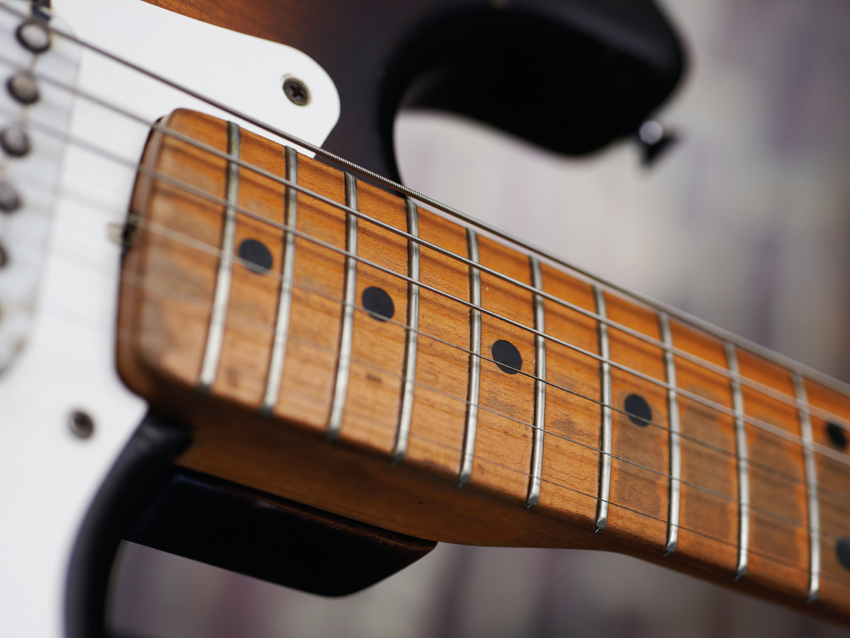
The guitar
It never ceases to amaze me: how the hell did they even imagine this in 1954, let alone make it?
In his book The Stratocaster Chronicles, respected guitar author and historian, Tom Wheeler, goes deep into the many accounts of how the Strat first came to be: who was involved and what their input was in order to present – if not entirely reconcile – some differences of opinion and memory from those early days.
It was ultimately Leo’s baby, nobody disputes that, and in its debut year, featured a highly stylised, ‘Comfort Contoured’ ash body, partly in response to player feedback that the Telecaster’s body edges were ‘sharp’ and uncomfortable. There were no CNC machines back then – if there were, Mr Fender would surely have used them – so the bodies were cut on a bandsaw, then shaped and sanded by hand. Ash was reportedly a little harder to work than alder, with a more open grain structure that also required more pore filler before finishing, two reasons the Strat later switched to mostly alder bodies during 1956.
Holding this one now, it’s hard to imagine that the solidbody guitar was still such a new phenomenon back then, widely referred to as the ‘Electric Spanish guitar’, in fact. It’s so curvy. Earlier Strats are known in general – and I stress ‘in general’ – to have slightly deeper, more rounded contours than later guitars. This one flaunts its 60-year-old shapeliness more elegantly than it has any right to, even if its thinned, worn nitrocellulose-lacquer coat has seen better days. It’s got to that wonderful point where it feels at one with the wood – and were it not for the prevalence of good vintage replicas these days, it would probably feel a little bit alien. You can feel more wood than finish; you can hear more music than guitar.
This neck came as a bit of a surprise. You might expect something fairly chunky, maybe even a V (not introduced until 1955, as I later discovered). It’s not one of the very thick, rounded profiles of ’54 folklore, but something that I’d happily pick up and play every day of the week. It feels remarkably like some of the modern-day Fender Heavy Relic necks, which is a testament to the Custom Shop’s attention to detail, perhaps more so to the original design’s enduring brilliance: it worked then, it still works now.
This one has had a refret at some point, making it all the more pleasurable to play; a little extra height on the frets makes choking less of an issue on the vintage-style, curvy maple playing surface (one piece with the neck, remember). You’d scarcely know this was a 60-year-old guitar, and that is perhaps the standout observation.
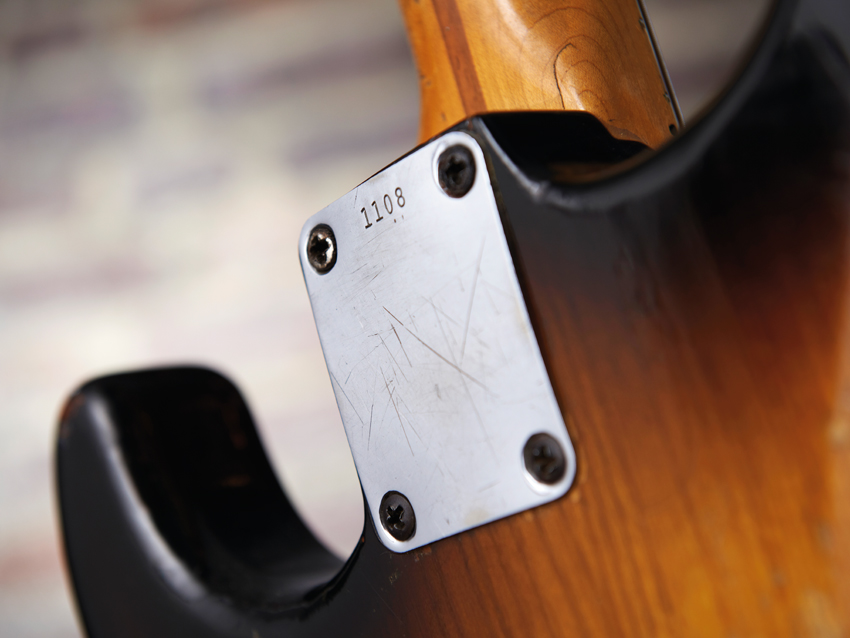
Number 1108
The first 100 or so Stratocasters from 1954 had their serial numbers stamped into the plastic vibrato-cavity plate, reverting to a four-digit number on the neck plate from around mid-1954.
This guitar has a non-1954 back plate, given away by its oval string holes; originals were round, turning oval in 1955, in order to facilitate easier string changes. Likewise, the tuners are non-original, having been replaced with post-1956-spec Klusons at some point.
As you can see, our guitar is numbered 1108, placing it most likely in latter ’54 (serial numbers were not sequential in terms of date, unfortunately), but along with certain other features, indicates that it may well have been produced on one of the first ‘official’ Stratocaster runs, in October 1954. A good many Strats predate that, of course, almost back to the beginning of the year, even before its ‘official’ release month of April 1954.
The knobs, pickup covers and switch tip are made from what’s often mistermed ‘Bakelite’. It has that slightly translucent look – particularly the pickup covers – and is in fact polystyrene. As you can see, our Strat’s pickup covers have suffered the same fate as those on Buddy Holly’s ’55 Strat, one reason Fender moved to using less-brittle plastics for knobs, switch tips (and later, pickguards).
By this point in late 1954, the Strat’s knobs had evolved to the modern shape we know now, and you might be surprised how white they are; the early white plastics didn’t discolour like later variants did.
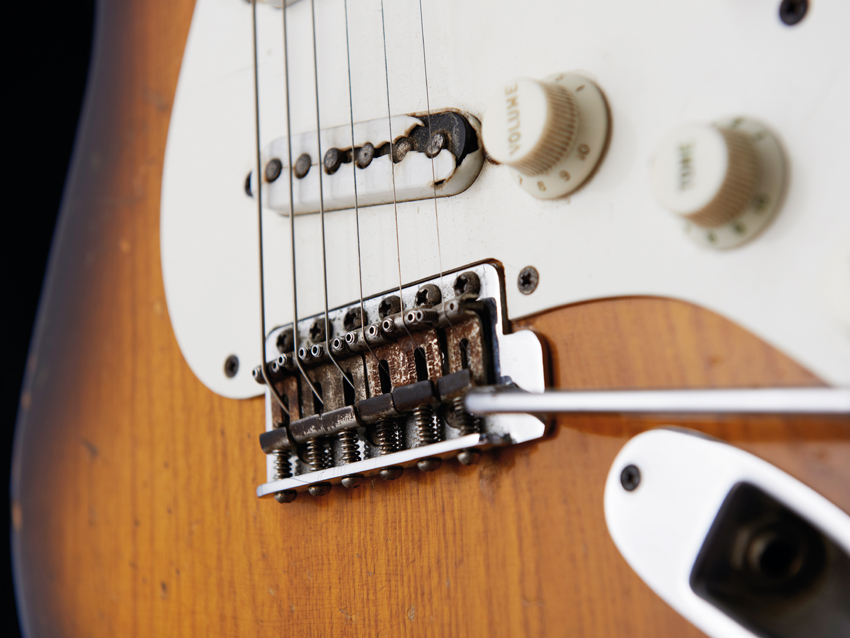
The vibrato
While Leo Fender and his colleagues were perfecting the ‘Synchronized Tremolo’ unit, 2,000 miles away in Kalamazoo, Michigan, Gibson was developing the Tune-O-Matic bridge.
For the first time, guitarists would have individual adjustment for string length (intonation), but in the Stratocaster’s case, that also meant individual string-height adjustment and a vibrato unit. Blissfully simple when you look at it now, it was nonetheless a revolution in guitar bridge design back in 1954, even if it did take regular maintenance and a deft hand to confidently hold tuning stability.
Many people – including me – would argue that there is nothing better for the optimum blend of tone, functionality and feel to this day.
Back then, if you’d chosen one with the new wobble-bar – non-Tremolo versions were offered a little later – you’d have had to fork out $249.50. The case was $39.95 extra, and: “of hardshell construction, crushed-plush lined... covered in a grain hair seal, simulated leather covering”, no less. The average US wage in 1954 was around $3,000, so a Strat would have been around a month’s wages.
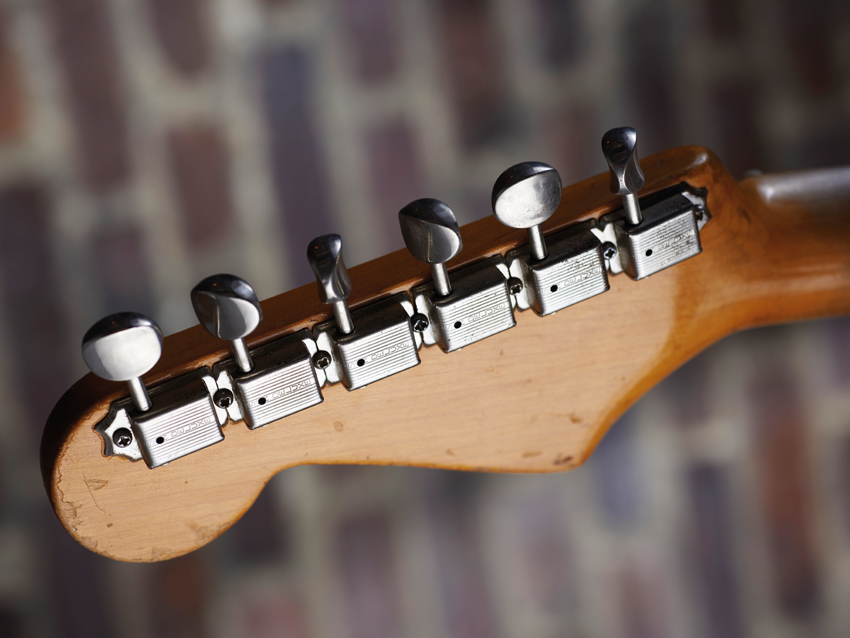
The myth, the legend
What did we learn on our trip to Umeå to see what its owners laughingly call this “old, dusty guitar”? Are we just perpetuating a vintage myth that has no relevance in modern music?
I don’t think so. What’s really astonishing about this guitar is that even 60 years after it was first designed and made, you could chuck it in a gigbag, go and do tonight’s gig and treat it like any other decent Stratocaster that has ever existed.
Perhaps we shouldn’t be too surprised, because however revolutionary, the Strat’s near-perfect blend of form and function lies right at the heart of its many other ostensible contradictions: versatile yet simple; futuristic yet timeless; workaday yet remarkable; all different, yet all strangely the same. Above all, it’s a guitar that you dream about, yet one which you can just go out and buy with a few hundred quid... as long as you don’t want this original ’54, of course!
So happy birthday Stratocaster, old buddy. I probably won’t see all of your next 60 years, but if they keep you safe, I know you’ll be as timeless then as you are now.

